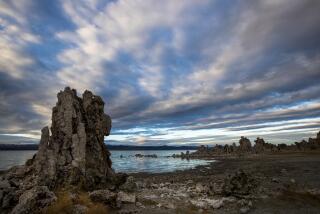Man-Made Lakes Test Human Ingenuity
- Share via
Over the last 30 years, the creation and care of man-made lakes such as Lake Sherwood have evolved into a science that is as complicated as the natural environment these bodies of water attempt to copy.
“Lakes have been created by dams for thousands of years without much thought going into them,” said J. Harlan Glenn, one of a handful of experts on man-made lakes and a consultant for the Lake Sherwood restoration. “But when you build a lake for a park or a residential development, you can’t just dig a hole, fill it up and see what happens.”
Lake Sherwood, which was completed in 1905, was formed by a dam to hold irrigation water for the ranch that eventually became Westlake Village, Glenn said. “Whenever a lake like that is created, people say, ‘Hey, wouldn’t it be great to live there,’ and that’s basically what happened with Lake Sherwood,” he said.
Like swimming pools, man-made lakes require regular use of some chemicals, as well as periodic cleaning, said Glenn, who owns an Orange County-based consulting firm. But maintaining a lake is substantially more complex than keeping a backyard pool because its waters are home to competing varieties of fish, birds, plants and microorganisms.
“A lake is a complicated web of life,” he said. “If one form of life grows out of proportion with the rest, it can throw the whole thing into a chaotic mess.”
As with many lakes, Lake Sherwood had been steadily deteriorating because of the growth of vegetation and the buildup of soil from surrounding hillsides. “It’s a natural phenomenon that all lakes will eventually dry up,” Glenn said.
Maintaining Lake Sherwood could cost between $250,000 and $500,000 a year, Glenn said. If a proposed project by the Murdock Development Co. is approved, the annual cost of lake maintenance will be spread among an estimated 820 Lake Sherwood households.
Lake Sherwood will need air pumps, fish, water, chemicals and regular cleaning, much the same elements as those needed in an aquarium, Glenn said. “All of these things cost money, and eventually, the users of the lake will have to bear those expenses,” he said.
Keeping the lake filled at the same level year after year would require the purchase of an average of 1,000 acre-feet of water annually, which would cost between $100,000 and $400,000 a year, Glenn said. An acre-foot is about 326,000 gallons.
In a normal year, the lake level will drop about five feet from evaporation, Glenn said. But if the area’s rainfall is less than normal over two consecutive years, the water level could drop as much as 13 feet in that time, he said. Lake Sherwood normally reaches an average depth of 15 feet, Murdock representatives said.
Problem of Vegetation
The bane of all lakes, both natural and man-made, is the unchecked growth of vegetation and algae, as well as the buildup of silt on the lake bottom, Glenn said.
Algae often presents a headache, Glenn said. It can foul boats’ motors, tangle fishing lines, is difficult to swim through and is unsightly, he said. It is fed by the phosphates and nitrates that come from hillside erosions, excrement from water fowl and seepage from septic tanks.
In natural lakes, microorganisms called zooplankton eat algae and are in turn eaten by certain varieties of fish, Glenn said. But when civilization encroaches on lakes, driving up phosphate and nitrate levels, then annual harvesting of plants and algae becomes the most effective way to control their growth, although chemicals are also used.
When a plant dies in the lake, “it decays, and that process consumes oxygen,” Glenn said. “When the lake loses oxygen, the fish die.”
Some use of chemicals such as lime and alum will be required to help rid Lake Sherwood of excess phosphates, Glenn said.
Small collection basins built around the lake will help by trapping soils and keeping out chemicals that feed the algae and plants in the water, Glenn said. The construction of a sewer system at Lake Sherwood, which is planned as part of the Murdock development, will also keep human wastes, which carry nitrates, from contributing to the problem, he said.
Still, even a scientist such as Glenn realizes that there are compromises that must be made. “Ducks also create an excrement problem; five ducks on the lake is equal to the organic waste of one human, but people like ducks on the lake,” he said.
Sediment Builds Up
The buildup of dead organisms, soils and other waste on the lake bottom creates several problems, the largest being displacement of lake water. An annual average of 140,000 cubic yards of sediment collects at the bottom of Lake Sherwood each year, which necessitates periodic dredging, Glenn said.
Glenn said he will recommend that Lake Sherwood be equipped with an aeration system to pump air into its lower levels to help prevent the buildup of decay. Without it, the dead plants and animals at the lake bottom will create a black sludge that produces hydrogen sulfide, a gas with the odor of rotten eggs, he said.
Finally, Lake Sherwood will continue to stock catfish and bluegill sunfish, which eat plants, as well as bass and mosquitofish, Glenn said.
More to Read
Sign up for Essential California
The most important California stories and recommendations in your inbox every morning.
You may occasionally receive promotional content from the Los Angeles Times.













